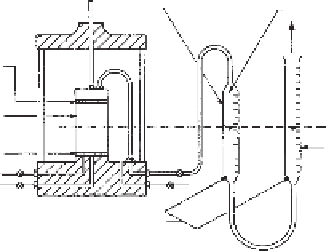Environmental Engineering Reference
In-Depth Information
Ballscrew
Remote
transducer
Pressure
cylinder
Stepper motor
and gearbox
Piston
Pressure
outlet
Digital
control
circuit
±
steps
Air
Deaired water
Linear bearing
Pressure
transducer
Analogue feedback
Figure 11.37
Details of operation of pressure-volume controllers. (Courtesy of GDS Instru-
ments, London.)
duration of the laboratory test exceeds 1 or 2 days. Several
other manufacturers also produce pressure-volume control
devices similar to those manufactured by GDS Instruments.
Closed burette
Air
Atmospheric
pressure
Coarse
porous
disk
Soil
11.4.6 Air Volume Change Measurement
The overall volume change of an unsaturated soil specimen
is equal to the sum of the water and air volume changes. The
soil particles and water can be assumed to be incompress-
ible. The measurements of any two of the above-mentioned
volume changes (i.e., overall volume change of the spec-
imen, water volume change, or air volume changes) are
necessary for describing the volume change behavior of
an unsaturated soil. The overall volume change and water
volume changes are generally measured while the air volume
change is computed as the difference between the measured
volume changes. Air volume change is somewhat difficult
to measure due to its high compressibility and sensitivity to
temperature change. Adams et al. (1996) showed, however,
that it was possible to use a GDS apparatus to also measure
air volume changes.
Figure 11.38 illustrates the use of two burettes to measure
air volume change under atmospheric air pressure conditions
(Bishop and Henkel, 1962; Matyas, 1967). Air moves out
of a soil specimen through a coarse porous disk and is col-
lected in a graduated burette. The burettes can be adjusted
to maintain the air-water interface at the midheight of the
specimen. The pore-air pressure is therefore maintained at
atmospheric pressure conditions. The changing elevation of
the air-water interface in the graduated burette indicates the
air volume change in the soil specimen. Water is prevented
from entering the burette because the gauge pore-water pres-
sure is negative. In addition, the coarse porous disk has a
low air-entry value. Water losses due to evaporation from
the open burette can be prevented by covering the water
surface with a layer of light oil (Head, 1986) or replacing
the water entirely with a light oil (Matyas, 1967).
The above method for measuring air volume change is
somewhat cumbersome. The apparatus shown is limited to
making measurements under atmospheric conditions. How-
ever, the apparatus can be modified such that it will operate
Specimen
midheight
High-air-
entry
disk
Open burette
Water
Figure 11.38
Air volume change measurements from triaxial cell
under atmospheric pressure conditions.
under an applied backpressure. The apparatus has been pri-
marily used to measure air coefficients of permeability.
11.4.7 Overall Volume Change Measurement
Overall volume change of a saturated soil specimen is equal to
the measured water volume change. For an unsaturated soil,
the water volume change constitutes only a part of the overall
volume change of a soil specimen. Overall volume change in
an unsaturated soil could be due to a change in the amount
of either air or water in the soil specimen. Consequently, it
is necessary to make a second volume change measurement
independent of the water volume change measurement.
It is generally preferable to measure the overall volume
change and also be able to separate horizontal strain com-
ponents from the vertical strain component. The air phase
is highly compressible, making its volume change some-
what difficult to measure. It would appear to be possible
to measure total volume change by measuring the flow of
water in or out from the triaxial cell fluid. The triaxial
cell fluid can be connected to a volume change indicator
that measures overall volume change of the soil specimen.
Most such attempts to measure overall volume change by
measuring fluid flow from the cell have met with limited
success. These measurements are susceptible to tempera-
ture change and errors introduced by leakage and diffusion.





























Search WWH ::

Custom Search